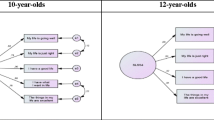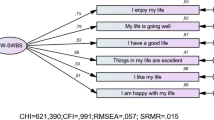Abstract
The third Wave Children’s Worlds dataset included data obtained from four self-reported well-being multi-item psychometric scales. Three of these were new improved versions of scales used in the second wave and the fourth had not been previously tested for reliability or comparability. The four scales were administered to children in the 10-year-olds age group in 35 countries and in the 12-year-olds age group in 30 countries. Many of these countries were not involved in the second wave. Consequently, the fit for all of these scales needs to be checked and its comparability among the new set of countries analysed. Based on our analysis, there can be no doubt that the most advisable psychometric scale for use in international comparisons is the 5-item version of the context-free subjective well-being scale for both the 10 and 12yo groups, because it displays metric invariance. Scalar invariance for this scale is only supported with a semi-partial constraint, because its item number 4 (Things in my life are excellent) seems to be very sensitive to the socio-economic level of the country, and generally tends to explain less variance than any other. Therefore, great caution must be used when comparing mean scores for this scale across countries. Items on the other three scales would appear to have different cultural meanings, depending on the country, as they do not display metric or scalar invariance across countries. However, the positive and negative affects scale deserves special attention, because the in-country correlation between its two components displays an interesting diversity between countries, probably due to cultural factors that should be further explored. Although statistics obtained using the overall index for any of these three scales cannot be meaningfully compared across countries, their fit is excellent and their use is deemed appropriate for in-country analysis. Further exploration is needed to test whether non-comparability is an issue with only some specific items, and whether they are comparable between some of the countries and not others.











Similar content being viewed by others
References
Adamson, P. (Ed.) (2007). Child poverty in perspective: An overview of child well-being in rich countries. Report Card 7. Innocenti Research Centre. UNICEF.
Andrews, F. M., & Withey, S. B. (1976). Social indicators of well-being: American’s perceptions of life quality. Plenum Press.
Arbuckle, J. L. (2010). IBM SPSS Amos 19 User's Guide. Amos Development Corporation.
Arthaud-Day, M. L., Rode, J. C., Mooney, C. H., & Near, J. P. (2005). The subjective well-being construct: A test of its convergent, discriminant, and factorial validity. Social Indicators Research, 74(3), 445–476. https://doi.org/10.1007/s11205-004-8209-6
Barrett, L. F., & Russell, J. A. (1998). Independence and bipolarity in the structure of current affect. Journal of Personality and Social Psychology, 74(4), 967–984.
Browne, M.W., & Cudeck, R. (1993). Alternative ways of estimating model fit. In K.A. Bollen, & J.S. Long (Eds.), Testing structural equation models (pp. 136–162). Sage.
Byrne B. M. (2010). Structural equation modelling with AMOS: Basic concepts, applications and programming (2nd ed.). Routledge.
Campbell, A., Converse, P. E., & Rodgers, W. L. (1976). The quality of American life: Perceptions, evaluations, and satisfactions. Russell Sage.
Cantril, H. (1965). The pattern of human concerns. Rutgers University Press.
Casas, F. (2017). Analysing the comparability of 3 multi-item subjective well-being psychometric scales among 15 countries using samples of 10 and 12-year-olds. Child Indicators Research, 10, 297–330. https://doi.org/10.1007/s12187-015-9360-0.
Casas, F., & Rees, G. (2015). Measures of children’s subjective well-being: Analysis of the potential for cross-national comparisons. Child Indicators Research, 8 (1), 49–69. https://doi.org/10.1007/s12187-014-9293-z
Casas, F., Sarriera, J. C., Abs, D., Coenders, G., Alfaro, J., Saforcada, E., & Tonon, G. (2012). Subjective indicators of personal well-being among adolescents. Performance and results for different scales in Latin-language speaking countries: A contribution to the international debate. Child Indicators Research, 5(1), 1–28. https://doi.org/10.1007/s12187-011-9119-1
Casas, F., Tiliouine, H., & Figuer, C. (2013). The subjective well-being of adolescents from two different cultures: Applying three versions of the PWI in Algeria and Spain. Social Indicators Research, 115, 637–651. https://doi.org/10.1007/s11205-012-0229-z
Chen, F. F. (2007). Sensitivity of goodness of fit indexes to lack of measurement invariance. Structural Equation Modeling: A Multidisciplinary Journal, 14(3), 464–504. https://doi.org/10.1080/10705510701301834
Cheung, G. W., & Rensvold, R. B. (2002). Evaluating goodness-of-fit indexes for testing measurement invariance. Structural Equation Modeling: A Multidisciplinary Journal, 9(2), 233–255. https://doi.org/10.1207/S15328007SEM0902_5
Coenders, G., Batista-Foguet, J.M., & Saris, W. (2005). Temas avanzados en modelos de ecuaciones estructurales. La Muralla.
Cummins, R. A. (1998). The second approximation to an international standard of life satisfaction. Social Indicators Research, 43, 307–334.
Cummins, R. A., & Nitisco, H. (2002). Maintaining life satisfaction: The role of positive cognitive bias. Journal of Happiness Studies, 3, 37–69. https://doi.org/10.1023/A:1015678915305
Cummins, R. A., Gullone, E., & Lau, A. L. D. (2002). A model of subjective well-being homeostasis: The role of personality. In E. Gullone, & R.A. Cummins (Eds), The universality of subjective well-being indicators (pp. 7–46). Social Indicators Research Book Series. Kluwer Academic Publishers.
Cummins, R. A., & Lau, A. L. (2005). Manual: personal wellbeing index - school children. (3rd ed.). School of Psychology, Deakin University.
Diamantopoulos, A., Sarstedt, M., Fuchs, C., Wilczynski, P., & Kaiser, S. (2012). Guidelines for choosing between multi-item and single-item scales for construct measurement: A predictive validity perspective. Journal of the Academy of Marketing Sciences, 40, 434–449. https://doi.org/10.1007/s11747-011-0300-3
Diener, E. (1984). Subjective well-being. Psychological Bulletin, 95, 542–575.
Diener, E., Emmons, R., Larsen, R., & Smith, H. L. (1985). The Satisfaction With Life Scale. Journal of Personality Assessment, 49(1), 71–75.
Diener, E., Suh, E. M., Lucas, R. E., & Smith, H. L. (1999). Subjective well-being: Three decades of progress. Psychological Bulletin, 125(2), 276–302.
Holte, A., Berry, M. M., Bekkhus, M., Borge, A. I. H., Bowes, L., Casas, F. et al. (2013). Psychology of child well-being. In Ben-Arieh, A., Casas, F., Frones, I., & Korbin, J.E. (Eds), Handbook of Child Well-Being (pp. 555–631). Springer. https://doi.org/10.1007/978-90-481-9063-8
Huebner, E. S. (1991). Initial development of the Student’s Life Satisfaction Scale. School Psychology International, 12(3), 231–240. https://doi.org/10.1177/0143034391123010
Marsh, H. W., Lüdtke, O., Muthén, B., Asparouhov, T., Morin, A. J. S., Trautwein, U., & Nagengast, B. (2010). A new look at the big five factor structure through exploratory structural equation modeling. Psychological Assessment, 22(3), 471–491. https://doi.org/10.1037/a0019227
Metler, S. J., & Busseri, M. A. (2017). Further evaluation of the tripartite structure of subjective wellbeing: Evidence from longitudinal and experimental studies. Journal of Personality, 85(2), 192–206. https://doi.org/10.1111/jopy.12233.Epub 2015 Dec 3.
Rees, G., Goswami, H., Pople, L., Bradshaw, J., Keung, A., & Main, G. (2013). The good childhood report. The Children's Society. https://www.basw.co.uk/resources/good-childhood-report-2013
Rees, G., & Main, G. (Eds.) (2015). Children’s views on their lives and well-being in 15 countries: A report on the Children’s Worlds survey, 2013–14. Children’s Worlds Project (ISCWeB). http://www.isciweb.org/_Uploads/dbsAttachedFiles/ChildrensWorlds2015-FullReport-Final.pdf
Rees, G., Savahl, S., Lee, B. J., & Casas, F. (2020). Children’s views on their lives and well-being in 35 countries: A report on the Children’s Worlds project, 2016–19. Children’s Worlds Project (ISCWeB). https://isciweb.org/wp-content/uploads/2020/07/Childrens-Worlds-Comparative-Report-2020.pdf
Ryan, R. M., & Deci, E. L. (2001). On happiness and human potentials: A review of research on hedonic and eudemonic well-being. Annual Review of Psychology, 52, 141–166. https://doi.org/10.1146/annurev.psych.52.1.141
Ryff, C. D. (1989). Happiness is everything, or is it? Explorations on the meaning of psychological well-being. Journal of Personality and Social Psychology, 57, 1069–1081.
Sarstedt, M., Diamantopoulos, A., & Salzberger, T. (2016). Should we use single items? Better not. Journal of Business Research, 69(8), 3199–3203. https://doi.org/10.1016/j.jbusres.2016.02.040
Seligson, J. L., Huebner, E. S., & Valois, R. F. (2003). Preliminary validation of the Brief Multidimensional Students’ Life Satisfaction Scale (BMSLSS). Social Indicators Research, 61(2), 121–145. https://doi.org/10.1023/A:1021326822957
Van Ginneken, J. K., & Groenewold, G. (2012). Open access a single- vs. multi-item self-rated health status measure: A 21-country study The Open Public Health Journal, 5, 1–9. Bentham Open.
Acknowledgements
Thanks are due to all children who kindly agreed to answer the questionnaire, to all principal investigators and to all research team members who participated in the data collection in the 35 countries included in the sample used here and to the co-ordinating team of the Children’s Worlds project for kindly allowing us to use the database, to the Jacobs Foundation for supporting the project, and to Barney Griffiths for the English editing of this paper.
Author information
Authors and Affiliations
Corresponding author
Ethics declarations
Ethical Approval
Legal and ethical standards corresponding to each country have been strictly adopted for the data collection.
Informed Consent
Informed consent has been collected from both parents and children.
Conflict of Interest
The corresponding author states that there is no conflict of interest.
Additional information
Publisher's Note
Springer Nature remains neutral with regard to jurisdictional claims in published maps and institutional affiliations.
Supplementary Information
Below is the link to the electronic supplementary material.
Rights and permissions
About this article
Cite this article
Casas, F., González-Carrasco, M. Analysing Comparability of Four Multi-Item Well-being Psychometric Scales Among 35 Countries Using Children’s Worlds 3rd Wave 10 and 12-year-olds Samples. Child Ind Res 14, 1829–1861 (2021). https://doi.org/10.1007/s12187-021-09825-0
Accepted:
Published:
Issue Date:
DOI: https://doi.org/10.1007/s12187-021-09825-0




